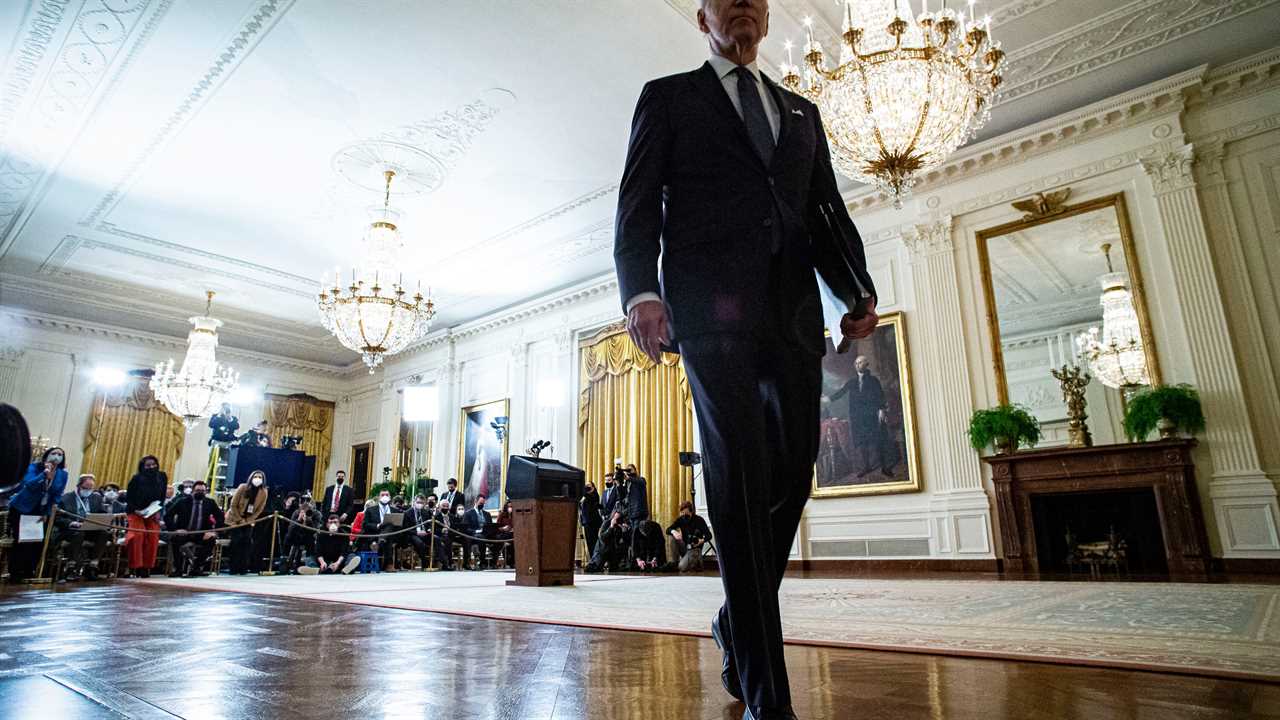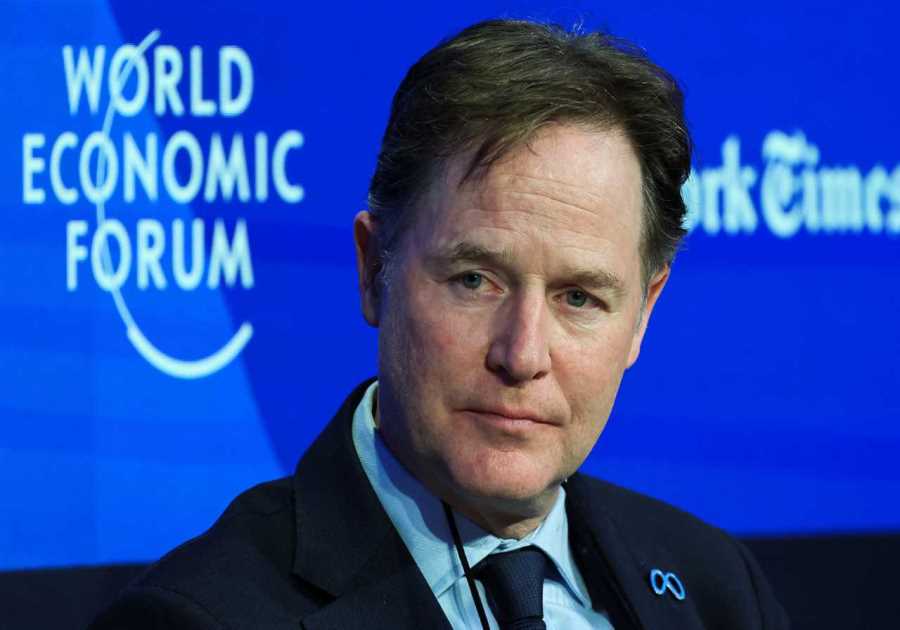
America’s chaotic exit from Afghanistan last year was a made-for-TV tragedy — complete with camera-ready scenes of frantic civilians, harried U.S. Marines and helicopters hovering over an embassy roof.
Ukraine is a foreign policy conundrum of an entirely different sort. President Biden’s task is to stop a war from beginning, not to end one with dignity. But even if he wards off a Russian invasion, he shouldn’t expect any ticker tape on Fifth Avenue.
“The politics of foreign policy are rarely fair, and this is the epitome of that kind of situation,” said John Gans, a former Pentagon speechwriter in the Obama administration. “You rarely get credit for the dogs that don’t bark.”
Our colleagues have been all over the national security aspects of the showdown with Moscow, including the latest news developments, with reporting by Julian E. Barnes and Helene Cooper on how the White House is trying to outfox Russia, and Michael Crowley’s look at Biden’s calculations.
But this is a political newsletter, so we must ask a crass question: Can Ukraine help Biden win back some of the public trust he lost after the Afghanistan pullout?
In conversations in recent days with current and former officials, members of Congress and Capitol Hill aides, we found broad support overall for Biden’s approach to Ukraine, although some Republicans complained about specific aspects of the strategy. But the president’s options for resolving the crisis, many said, could give critics an opening. And, as Biden warned in his remarks on Tuesday, confronting Vladimir Putin is not likely to be “painless” for Americans, even if Russia relents.
Quieting the doubters
For the moment, Biden has faced some criticism on the right, but there’s been no sustained chorus of rebukes from either party.
Republicans aren’t speaking with one voice. They are split between those, like Senator Tom Cotton of Arkansas, who are agitating for a harder line against Moscow, and skeptics like Tucker Carlson of Fox News who say that Ukraine is not America’s problem. The party lost in 2018 its most prominent hawk, Senator John McCain of Arizona, while its current leader, Donald Trump, makes for a less than ideal messenger when it comes to Russia.
The White House has also kept leading progressives on board. Senator Bernie Sanders of Vermont has praised the administration for “doing its best walking a very difficult tightrope,” while Senators Elizabeth Warren of Massachusetts and Jeff Merkley of Oregon told HuffPost that they support Biden’s strategy.
Unlike with Afghanistan, criticism from the foreign policy establishment has been muted.
“I think they started with a bit of an analytical mistake — that they could have a stable and predictable relationship with Russia so they could focus on China,” said Michael McFaul, a former ambassador to Moscow in the Obama administration. “But, generally, I’m impressed.”
Understand Russia’s Relationship With the West
The tension between the regions is growing and Russian President Vladimir Putin is increasingly willing to take geopolitical risks and assert his demands.
- Competing for Influence: For months, the threat of confrontation has been growing in a stretch of Europe from the Baltic Sea to the Black Sea.
- Threat of Invasion: As the Russian military builds its presence near Ukraine, Western nations are seeking to avert a worsening of the situation.
- Energy Politics: Europe is a huge customer of Russia’s fossil fuels. The rising tensions in Ukraine are driving fears of a midwinter cutoff.
- Migrant Crisis: As people gathered on the eastern border of the European Union, Russia's uneasy alliance with Belarus triggered additional friction.
- Militarizing Society: With a “youth army” and initiatives promoting patriotism, the Russian government is pushing the idea that a fight might be coming.
Since November, the administration has held more than 300 “diplomatic engagements” with partners and allies. Biden has sent troops to bolster jittery NATO allies in Eastern Europe. And the White House has used information as a weapon of deterrence, declassifying and disclosing intelligence to disrupt possible Russian operations in real time.
Andrea Kendall-Taylor, a former deputy national intelligence officer for Russia, described this as an effort to “build a common threat picture.”
That much has worked so far. European countries that might otherwise have gone wobbly, notably Germany, have agreed to impose severe sanctions should Putin decide to invade.
“Trump couldn’t have done this,” said Daniel Fried, a longtime Russia expert who retired in 2017 as the State Department’s coordinator for sanctions policy. “Trump wouldn’t have been interested.”
The tricky part is what happens next
Putin might still attack, of course, which would raise questions about the White House’s strategy. And he has options short of war, too: Annexing parts of Ukraine. Squeezing Kyiv economically. Wielding Russia’s energy resources to divide European countries. Launching cyberattacks. Forcing up the price of oil.
Giving Putin an off-ramp could require a painful, protracted negotiating process, potentially leading to accusations that the United States is feeding Ukraine to the Russian wolf.
Building a cross-aisle coalition in Washington won’t be easy, either.
On Tuesday, as discussions on a bipartisan bill to penalize Russia broke down, the best Congress could cobble together was a statement expressing solidarity with Ukraine. Two of the holdouts were Cotton and Senator Ted Cruz of Texas, both of whom harbor presidential ambitions. Senate Republicans introduced their own punitive legislation — the Never Yielding Europe’s Territory, or NYET Act, a rhetorical flourish in the form of a bill that would halt Nord Stream 2, a Baltic Sea gas pipeline meant to bypass Ukraine.
The proposal was a reminder that Republicans have a megaphone but no real responsibility. And in an election year, national security can get political in a hurry.
Don’t expect a Ukraine bump
Historically, any effect that foreign crises have on public opinion tends to be ephemeral.
After John F. Kennedy led the United States out of the Cuban missile crisis, his approval rating soared to 76 percent. By the time of his assassination a year later, it had fallen to the upper 50s. George H.W. Bush’s approval rating reached 89 percent after the first Gulf War, but it sank to 29 percent as the economy slumped, and he lost re-election to Bill Clinton. Killing Osama bin Laden bought Barack Obama about a month of buoyant poll numbers, at most.
But when things go wrong abroad, the damage to a president’s credibility can be devastating. Lyndon B. Johnson declined to run for re-election after the Tet offensive in Vietnam helped drive his approval ratings into the mid-30s. The seizure of American hostages in Iran paralyzed Jimmy Carter, contributing to his defeat in 1980. And though George W. Bush was re-elected in 2004, Iraq haunted the remainder of his presidency.
David Axelrod, a former senior adviser to Obama, said that Biden has been “very smart, strong and deliberate” on Ukraine. “Even as most Americans are focused closer to home,” he added, “‘smart, strong and deliberate’ are welcome adjectives for this president after a challenging six months.”
Should Putin gain the upper hand, though, history’s judgment could be harsh. And even if things go well, some question the wisdom of devoting so much attention to a region that represents the geopolitical past, not its future.
“We have to focus on China,” said Elbridge Colby, a former Pentagon official in the Trump administration. “The military situation in Asia is increasingly acute, and we’re way behind. Russia’s a secondary issue.”
What to read
J. David Goodman caught up with Beto O’Rourke on the campaign trail, as he seeks to become the first Democratic governor of Texas in decades.
Dana Remus, Biden’s White House counsel, ordered the National Archives to turn over the White House visitor logs to the congressional committee investigating the Jan. 6 attack on the Capitol.
Residents of San Francisco voted to recall three members of the city’s school board, a move that suggests that anger over the direction of public education during the pandemic extends to liberal as well as conservative parents.
HOW THEY RUN
The 30th retirement
Representative Kathleen Rice of New York announced on Tuesday that she won’t run for re-election in her Long Island district. As Annie Karni reported, Rice’s decision means that more Democrats are calling it quits this year than they have since 1992.
Rice is the 30th House Democrat to make a retirement announcement — a statistic Republicans are celebrating as a sign that those Democrats are getting out to avoid brutal midterm elections.
But that doesn’t tell the entire story.
The raw number of retirements matters. But so does the kind of seats that Democrats are leaving, and the timing of their decisions in a redistricting year.
“It’s a rush to the exits, but not yet an all-hands-abandon-ship moment,” said Michael Li, a redistricting expert and senior counsel for the Brennan Center’s Democracy Program.
When a redistricting year overlaps with midterm elections, there’s extra motivation for members of Congress to consider retiring. For some, redistricting eliminates their districts outright. For others, it means they have to introduce themselves to new constituents, which costs money and means spending more time wooing donors.
Either situation makes for a convenient time to leave Washington.
Dan Sena, who led House Democrats’ campaign arm when they retook the majority in 2018, told us that he didn’t find the number of retirements to be particularly concerning.
“The vast majority of these districts are Democratic districts,” he said.
So far, just a handful of the districts that Democrats are leaving are expected to be competitive in the general election.
It’s possible that the retirement list will look worse for Democrats in a few months than it does now. While Rice’s seat favors Democrats, multiple nonpartisan analysts have noted that in a big enough wave, Republicans could flip it.
But the writing on the wall was much clearer, and worse, for the party in power in Trump’s first midterm election in 2018, when Republicans headed for the exits in droves. At least half a dozen Republicans who retired, resigned or ran for a different political office before the 2018 election were representing districts that Hillary Clinton carried in 2016, making them the lowest-hanging fruit for Democrats. A couple of Republicans who represented districts that Trump had only narrowly carried called it quits, too.
Among this year’s retirements, Li said, only one Democratic incumbent, Representative Ann Kirkpatrick of Arizona, would have run for re-election in a district that Trump carried.
Thanks for reading. We’ll see you tomorrow.
— Blake & Leah






